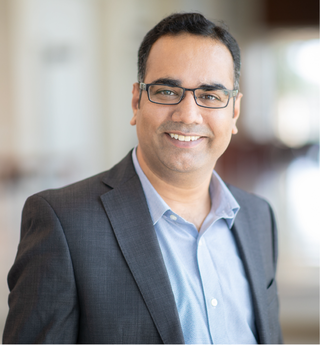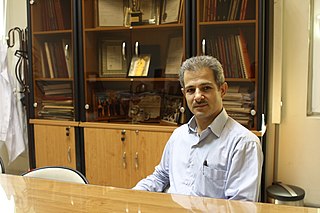Related Research Articles

Regenerative medicine deals with the "process of replacing, engineering or regenerating human or animal cells, tissues or organs to restore or establish normal function". This field holds the promise of engineering damaged tissues and organs by stimulating the body's own repair mechanisms to functionally heal previously irreparable tissues or organs.

The Institute of Physics and Engineering in Medicine (IPEM) is the United Kingdom's professional body and learned society for physicists, engineers and technologists within the field of medicine, founded in 1995, changing its name from the Institution of Physics and Engineering in Medicine and Biology (IPEMB) in 1997. The Institute is governed by an elected Board of Trustees reporting to which are the Science, Research and Innovation Council and the Professional and Standards Council. The councils have operational responsibility for scientific and professional aspects of the Institute's work, respectively. Beneath the councils is a substructure of committees, groups and panels of members, which undertake the work of the Institute.
Peter W. Zandstra, is a Canadian scientist who is the Director of the Michael Smith Laboratories at the University of British Columbia.

Sangeeta N. Bhatia is an American biological engineer and the John J. and Dorothy Wilson Professor at MIT’s Institute for Medical Engineering and Science and Electrical Engineering and Computer Science (EECS) at the Massachusetts Institute of Technology (MIT) in Cambridge, Massachusetts, United States. Bhatia's research investigates applications of micro- and nano-technology for tissue repair and regeneration. She applies ideas from computer technology and engineering to the design of miniaturized biomedical tools for the study and treatment of diseases, in particular liver disease, hepatitis, malaria and cancer.
Nick Rhodes is a Reader in Tissue Engineering and Regenerative Medicine at the University of Liverpool, in the U.K. Tissue Engineering can be described as the use of engineering techniques, including engineering materials and processes, in order to grow living tissues. Regenerative Medicine can be described as the treatment of defective tissues using the regenerative capacity of the body's healthy tissues. Rhodes describes the discipline as "aiming to repair tissue defects by driving regeneration of healthy tissues using engineered materials and processes."
Kristi S. Anseth is the Tisone Distinguished Professor of Chemical and Biological Engineering, an Associate Professor of Surgery, and a Howard Hughes Medical Investigator at the University of Colorado at Boulder. Her main research interests are the design of synthetic biomaterials using hydrogels, tissue engineering, and regenerative medicine.

Gordana Vunjak-NovakovicFRSC is a Serbian American biomedical engineer and university professor. She is a University Professor at Columbia University, as well as the Mikati Foundation Professor of Biomedical Engineering and Medical Sciences. She also heads the laboratory for Stem Cells and Tissue Engineering at Columbia University. She is part of the faculty at the Irving Comprehensive Cancer Center and the Center for Human Development, both found at Columbia University. She is also an honorary professor at the Faculty of Technology and Metallurgy at the University of Belgrade, an honorary professor at the University of Novi Sad, and an adjunct professor at the Department of Biomedical Engineering at Tufts University.

Tissue Engineering and Regenerative Medicine International Society is an international learned society dedicated to tissue engineering and regenerative medicine.
The Woolmer lecture is the flagship lecture of the Institute of Physics and Engineering in Medicine. It takes place annually during the Institute's Medical Physics and Engineering Conference.
Robert M. Nerem, often referred to as Bob Nerem, a member of the U. S. National Academy of Engineering and the Institute of Medicine, held the Parker H. Petit Distinguished Chair for Engineering in Medicine and Institute Professor Emeritus at the Georgia Institute of Technology where he was an Emeritus Professor until his death.

Akhilesh K. Gaharwar is an Indian academic and an associate professor in the Department of Biomedical Engineering at Texas A&M University. The goal of his lab is to understand the cell-nanomaterials interactions and to develop nanoengineered strategies for modulating stem cell behavior for repair and regeneration of damaged tissue.

Sheila MacNeil is a Professor of Tissue Engineering at the University of Sheffield. She works alongside NHS clinicians to use tissue engineered skin to benefit patients with burns, chronic ulcers and those recovering from surgery. She developed MySkin, skin bandages that are used to treat burns in 11 of 13 major UK burns units.
Laura E. Niklason is a physician, professor and internationally recognized researcher in vascular and lung tissue engineering. She is the Nicholas M. Greene Professor of Anesthesiology and Biomedical Engineering at Yale University and co-founder, chief executive officer and president of Humacyte, a regenerative medicine company developing bioengineered human tissues.
Sarah Harriet Cartmell is a British biomaterials scientist and Professor of Bioengineering at the University of Manchester. She specializes on the potential use of electrical regimes to influence cellular activity for orthopaedic tissue engineering applications.
Rebecca Julia Shipley is a British mathematician and professor of healthcare engineering at University College London (UCL). She is director of the UCL Institute of Healthcare Engineering, co-director of the UCL Centre for Nerve Engineering and Vice Dean (Health) for the UCL Faculty of Engineering Sciences. She is also co-director of the UCL CHIMERA Research Hub with Prof Christina Pagel and a Fellow of the Institution of Engineering and Technology.
Susmita Bose is an Indian-American scientist and engineer, best known for her research on biomaterials, 3D printing or additive manufacturing of bone implants and natural medicine. She is the Herman and Brita Lindholm Endowed Chair Professor in the School of Mechanical and Materials Engineering at Washington State University.

Mohamadreza Baghaban Eslaminejad is the director of the Adult Stem Cell Lab and histology/embryology Professor at the Royan Institute where he held a multi-departmental professorship in bioengineering, tissue engineering, regenerative medicine, and stem cell therapy. Eslaminejad studies have been cited over 4000 times. He is best known for Hard Tissue Engineering and utilizing Mesenchymal stem cells for treatment of orthopedic diseases.
Sina Y. Rabbany is the Jean Nerken Distinguished Professor of Engineering at Hofstra University, dean of the Fred DeMatteis School of Engineering and Applied Science, founding director of the school's Bioengineering program, and adjunct associate professor of bioengineering at the Weill Cornell Medical College of Cornell University. Under his tenure, the DeMatteis School's fast growth led to the school's planned expansion into a new Science and Innovation Center. His research concerns cellular and tissue engineering of the vascular system and investigates the impact of the biophysical microenvironment on the structure and function of endothelial cells. His research explores the capabilities of endothelial cells to build functional blood vessels and support organ regeneration. His h-index is 28 by Google Scholar.
Helen Haiyan Lu is a Chinese American biomedical engineer and the Percy K. and Vida L. W. Hudson professor of biomedical engineering at the Columbia University Fu Foundation School of Engineering and Applied Science. Her work focuses on understanding and developing therapies in complex tissue systems, especially the interface between soft tissue and bone.
Melissa Louise Mather is an Australian physicist who is Professor in Biological Sensing and Imaging at the University of Nottingham. Her research considers the development of novel sensing techniques, including ultrasound, single molecule imaging and nitrogen-vacancy centers in diamond.
References
- ↑ "Professor Alicia El Haj – School of Chemical Engineering – University of Birmingham". www.birmingham.ac.uk. Retrieved 21 September 2019.
- ↑ "Royal Academy of Engineering". Archived from the original on 24 September 2017.
- 1 2 3 "EPSRC | Doctoral Training Centre". www.lboro.ac.uk. Retrieved 9 June 2018.
- ↑ "Alicia El Haj – EPSRC website". epsrc.ukri.org. Retrieved 9 June 2018.
- ↑ "Birmingham Rowing Club" . Retrieved 9 June 2018.
- 1 2 University, Keele. "Alicia Elhaj, Keele University". www.keele.ac.uk. Retrieved 9 June 2018.
- ↑ "Articles – Engineering cells to grow tissue". www.ingenia.org.uk. Retrieved 9 June 2018.
- ↑ "Alicia J El Haj". royalsociety.org. Retrieved 9 June 2018.
- ↑ "Royal Society Wolfson Merit Award for Prof Alicia El Haj". Keele University. Retrieved 9 June 2018.
- ↑ Greenemeier, Larry (17 March 2015). "Launch the Nanobots!". Scientific American. 312 (4): 50–51. Bibcode:2015SciAm.312d..50G. doi:10.1038/scientificamerican0415-50. ISSN 0036-8733.
- ↑ "Funny bone". The Economist. 30 January 2003. Retrieved 9 June 2018.
- ↑ "MRC Suffrage Science Award 2015 for Professor Alicia El Haj". Keele University. Retrieved 9 June 2018.
- ↑ "Break for the Borders". LMS London Institute of Medical Sciences. 8 March 2017. Retrieved 9 June 2018.
- ↑ author, EPSRC. "Grants on the web" . Retrieved 9 June 2018.
{{cite web}}:|last=has generic name (help) - ↑ "New Fellows 2017". RAEng. 9 June 2018. Retrieved 9 June 2018.
- ↑ "IPEM > About IPEM > Governance of IPEM > IPEM BES Integration". www.ipem.ac.uk. Retrieved 9 June 2018.